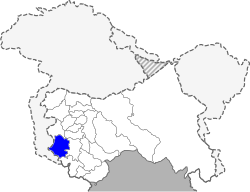In the district, a relatively large proportion of the net sown area is unirrigated, indicating high irrigation demand. Horticulture crops occupy a relatively low proportion of gross cropped area in the district, diminishing the economic viability of solar pumps here. Overall, water availability for irrigation in the district (based on ground water development and long-term trends of water level decline) is within the safe limit, enhancing long-term sustainability of solar pumps. There is a comparatively high level of farm mechanization in the district, implying a positive outlook towards progressive technologies amongst the farmers. The district has a relatively high proportion of small and marginal farmers. The district appears in the group of districts, which are (very) highly vulnerable towards climate change, as per an index constructed by CRIDA.
Deployment Approaches
| Approaches | Feasibility |
|---|---|
| Individually owned off-grid solar pumps | Limited Suitability |
| Solarisation of feeders | Not Suitable |
| Solar based water as a service | Suitable |
| Promote 1 HP and sub-HP pumps | Limited Suitability |
| Solarisation of individual grid-connected pumps | Not suitable |
Individually owned off-grid solar pumps
Limited Suitability
The district has ground water available within the safe limit. But, a comparatively low concentration of diesel pump users, low crop revenue per holding, and a relatively low disbursement of institutional credit make it very difficult to promote the private ownership of solar pumps here.
| Parameter | Value | Percentile |
|---|---|---|
| Number of cultivators reporting use of diesel pumps | 10,247 | 42 |
| Water Availability Index | 1 | 100 |
| Crop revenue per holding (INR) | 52,388 | 35 |
| Medium and long term institutional credit disbursed in a year (in INR Crore) | 0 | 0 |
Solarisation of feeders
Not Suitable
The district has a relatively high penetration of electric pumps. But, a rather low cost of power supply for the respective DISCOM and a comparatively low extent of feeder segregation make it very difficult to solarise the feeders here.
| Parameter | Value | Percentile |
|---|---|---|
| Actual cost of power supply (INR/kWh) | 4.19 | 2 |
| Extent of feeder segregation | 0% | 0 |
| Proportion of cultivators reporting use of electric pumps | 13% | 61 |
Solar based water as a service
Suitable
Availability of groundwater within the safe limit, a relatively high proportion of unirrigated area, and a rather high concentration of small and marginal farmers in the district make the water-as-a-service model a potential way to promote solar-based irrigation. The model could help in improving irrigation equity, without requiring a farmer to bear an upfront cost to purchase a pump.
| Parameter | Value | Percentile |
|---|---|---|
| Water Availability Index | 1 | 100 |
| Proportion of small and marginal cultivators | 87% | 53 |
| Unirrigated net sown area as a share of total net sown area | 92% | 84 |
Promote 1 HP and sub-HP pumps
Limited Suitability
The district has groundwater availability within safe limit, a rather high concentration of marginal farmers, and a comparatively high disbursement of institutional credit to marginal farmers, but the proportion gross cropped area under horticulture crops is relatively low. Farmers should be incentivised to grow horticulture crops based on the agro-economic suitability of the region and market linkages to improve their revenue, making small sized pumps viable, by improving their capacity utilisation.
| Parameter | Value | Percentile |
|---|---|---|
| Area under horticulture crops as a share of gross cropped area | 1% | 12 |
| Water Availability Index | 1 | 100 |
| Proportion of marginal cultivators | 65% | 51 |
| Medium and long term institutional credit disbursed in a year (in INR Crore) | 0 | 0 |
Solarisation of individual grid-connected pumps
Not suitable
The district has a relatively high penetration of electric pumps and ground water available within the safe limits. But, a relatively low power subsidy for agriculture consumers and a comparatively low extent of feeder segregation make it very difficult to solarise individual grid-connected pumps here.
| Parameter | Value | Percentile |
|---|---|---|
| Water Availability Index | 1 | 100 |
| Actual cost of power supply (INR/kWh) | 4.19 | 2 |
| Extent of feeder segregation | 0% | 0 |
Leveraging Solar Pumps to Promote Policy Objectives
If you are deploying solar pumps in this district then you can further these policy objectives.
Har Khet ko Pani
A relatively high proportion of the net sown area in the district is unirrigated, indicating high irrigation demand. Solar pumps can help improve access to underground irrigation as part of Har Khet ko Pani.
| Parameter | Value | Percentile |
|---|---|---|
| Unirrigated net sown area as a share of total net sown area | 92% | 84 |
Doubling Farmers’ Income – Crop Intensity
A relatively high proportion of the district’s net sown area is unirrigated. Lack of access to irrigation is one of the major barriers to growing crops beyond two conventional seasons, rabi and kharif. Ensuring irrigation access through solar power will help improve cropping intensity and move towards the aim of doubling farmers’ income by 2022.
| Parameter | Value | Percentile |
|---|---|---|
| Unirrigated net sown area as a share of total net sown area | 92% | 84 |
Doubling Farmers’ Income – Crop Diversification
In the district, horticulture crops occupy a relatively low proportion of gross cropped area, indicating an opportunity for growing more high value non-staple crops. Solar-powered irrigation could be an alternative source of reliable irrigation, making it easier to achieve crop diversification and enhance farmers’ incomes.
| Parameter | Value | Percentile |
|---|---|---|
| Area under horticulture crops as a share of gross cropped area | 1% | 12 |
National Mission on Oilseeds and Oil Palm (NMOOP)
The relatively low share of oilseeds and oil palm crops under gross sown area in the district makes it a suitable candidate for promoting NMOOP. Solar pumps could meet irrigation needs for these crops and help farmers diversify their yields beyond cereals.
| Parameter | Value | Percentile |
|---|---|---|
| Area under oilseeds as a share of total cropped area | 15 |
Climate Resilient Farming for Small Farms
Given the high concentration of small and marginal farmers—the most vulnerable group to climate change—and a high score on climate change vulnerability index provided by CRIDA*, the district is suitable for promoting climate resilient farming for small-sized farms. Solar pumps would assist in the same through low-carbon agriculture.
| Parameter | Value | Percentile |
|---|---|---|
| Proportion of small and marginal cultivators | 87% | 53 |
| Score on Climate Change Vulnerability Index | 0.47 | 62 |


